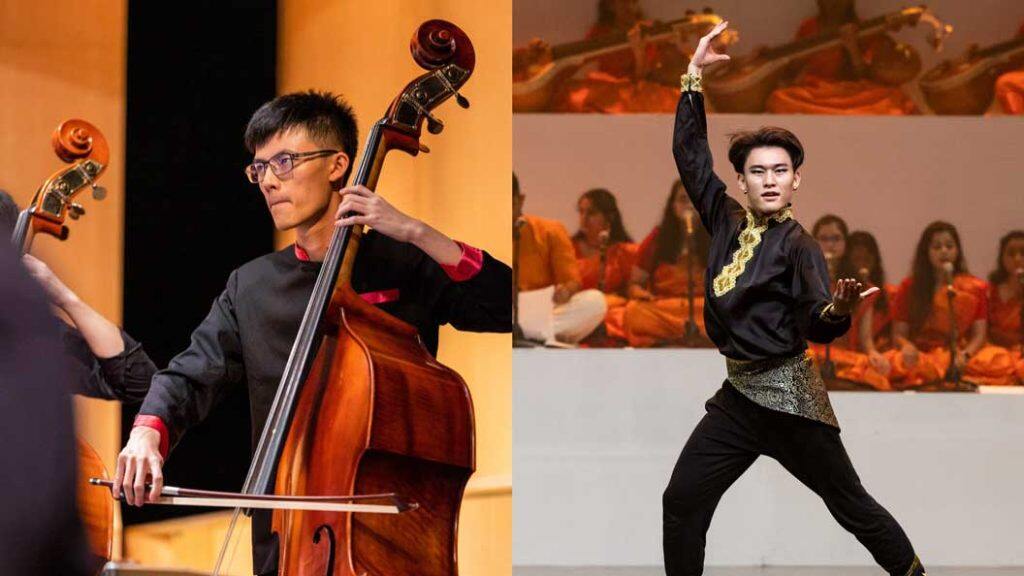The arts support framework will enhance experiential and interdisciplinary learning through greater participation in the arts.


The arts are often seen as a lofty pursuit, requiring copious amounts of time and energy to perfect one’s skills to become a “true” artist. Yet whether one is a dedicated practitioner or a casual enthusiast, there are benefits to engaging with the arts at any level.
A new Arts For All (AFA) framework developed by the Office of Student Affairs Centre for the Arts (CFA) aims to make the arts more accessible to undergraduates at the National University of Singapore (NUS) by lowering the barriers to entry with flexible support for a broad spectrum of activities. The goal is to integrate the arts more deeply into student life and the academic journey at NUS, augmenting the University’s ongoing efforts to enhance experiential and interdisciplinary learning through greater participation in the arts.
AFA supports a diverse range of artistic learning opportunities so that students can access the arts in ways that best suit their developmental objectives, interests, and levels of commitment. Examples include project grants for ground-up and student-led community initiatives, as well as structured training for students who wish to develop their artistic practice more intensively.
Associate Professor Chan Tze Law, Vice Dean of Students who oversees CFA, said the AFA framework will allow more students to experience the arts and embrace it as an essential part of their lives.
“The hope is that in five years’ time, (AFA) is an integral part of NUS student life,” said Assoc Prof Chan, who is also Vice Dean (Career Orientation & Community Engagement) of the Yong Siew Toh Conservatory of Music (YST). “The ideal situation would be when every NUS student has a little bit of arts DNA in them.”
A new approach to arts education in NUS
One of the key AFA initiatives is the introduction of the Performing Arts in Practice courses for students to further their practice-based skills in a structured academic setting. Administered by YST and piloted since August 2023, these year-long courses allow students to earn academic credits, or “units”, for their participation in selected performing arts groups under CFA.
About 160 students are currently enrolled in the four credit-bearing groups: NUS Chinese Dance, NUS Chinese Orchestra, NUS Symphony Orchestra, and NUS Wind Symphony. NUS expects more of the 32 performing arts groups directly managed by CFA to join these four as credit-bearing groups over time.
The courses also lay the foundation for another highlight of the AFA framework – the newly launched Second Major and Minor in Performing Arts – as students can use the academic credits to fulfil elective requirements or stack them towards the Minor or Second Major.
Over the past year, students in the credit-bearing arts groups have experienced a slightly different approach to honing their artistic skills under the Performing Arts in Practice courses. They now follow a structured curriculum that trains and assesses them not only in performing excellence, but also in other aspects such as community outreach, recruitment, and art leadership to hone their engagement and collaboration abilities.
For instance, a collaboration between NUS Chinese Orchestra and NUS Chinese Dance required the students to plan and deliver a performance to introduce their art forms to an audience of Primary 6 students. The undergraduates were assessed on factors like the concert programme design, audience interaction components, relevance to the audience, and the overall performance.


NUS Chinese Orchestra President Huang Chao Hung, who is a second-year Data Science student at the Faculty of Science, said the new approach has increased his appreciation for the art through exploring more Chinese orchestral pieces and understanding how a performance is planned and executed. “The credit-bearing course has made me want to learn more about the art form and its possibilities,” he said.
Another activity conducted by NUS Chinese Dance members involved teaching patients at St Luke’s Hospital about Chinese fan dance with a short routine, shared Yong Fong Sin, a second-year Life Sciences student at the College of Humanities and Sciences who is a part of the NUS Chinese Dance executive committee.
He said: “It was heartwarming to introduce the art to them and get them involved, and I learned that performing art is not just about performing, but also about how we can connect to different audiences.”
While the concept of being graded for their participation in a performing arts group may seem daunting to some, several students said they found it more motivating than stressful.
Sharmila Selvam, a second-year Engineering Science student who plays the trumpet and is the secretary-treasurer for the NUS Wind Symphony, said, “I’m not too worried about the grading because my priority for the art will continue to be personal enjoyment rather than academic grades, which now comes as a bonus.”


Said Ang Zien Xu, a first-year Computer Science major who plays the violin with the NUS Symphony Orchestra: “I believe most people that join a performing arts group do not join just for the grade but rather because they enjoy performing their art and want to continue doing so in the university.
“After having been through almost a year of the course, it has not changed the way I view my art, or the way I practise it. Rather, this provides me with an incentive to attend rehearsals, knowing that my efforts are being recognised.”
Cultivating a more vibrant arts scene
The students are optimistic that AFA will foster a more vibrant arts ecosystem in NUS as more students get to experience different art forms, whether as beginners or advanced practitioners, through new groups or collaborations between existing groups.
“My hope is that it will be able to cultivate more interest in the performing arts amongst students and encourage the formation of more performing arts groups, so that students can explore and experience the arts in different forms,” said Fong Sin, who also looks forward to AFA promoting higher artistic standards among existing arts groups.
Sharmila is keen to see how the AFA framework could encourage students to continue to stay engaged and further their progress in their chosen art forms. “I’ve been in the arts since primary school and in band and theatre for 10-12 years, and I have seen many people lose their passion for the arts because they are not motivated even though they are very talented,” she said. “Hopefully, the AFA framework will simplify the process for them or make it easier for existing groups to try to create new projects or start new concerts.”
Zien Xu anticipates that the broader support from AFA will prompt more collaborations between performing arts groups such as joint performances or exhibitions, interdisciplinary workshops, community engagement projects, and informal jam sessions. “In my opinion, one of the best ways to motivate performing art students is to give them performing opportunities to showcase their art,” he said.
Read the full press release here, and find out more about the AFA framework here.








































